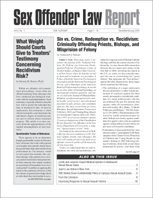Reconsidering the Story Model of Jury Decision-Making in Consent- Defense Rape Cases and the Efficacy of Rape Trauma Syndrome Evidence
Author: Douglas D. Koski, JD, PhD.; Roslyn Myers, Esq..
Source: Volume 02, Number 05, August/September 2001 , pp.65-72(8)

next article > |return to table of contents
Abstract:
This is the first study published in the United States that applies the “story model” of jury decision-making to rape cases in which the defense is that of consent. The study presented here applies this model specifically to juries’ use of the jury instructions in such cases. As originally conceptualized, the story model suggests that juries use the shorthand device of the narrative (“story,” “script,” or “plot line”) to construct a laypersons’ conception of the facts of the case, after which they pick the verdict—generally “guilty” or “not guilty”— that the story best matches. Although the story model of jury decision-making is intuitively reasonable, this study seems to show, among other things, that jury decision-making operates in precisely the opposite way as the story model suggests in most cases. That is, jurors generally make up their minds about the appropriate verdict before deliberations begin, after which they construct stories to support the verdict to which the majority has agreed. In other words, the story—however idiosyncratic to the 12-member jury that decides the case—is used to justify and to explain the verdict that is foreordained by the will of the majority. Additionally, the study reported in this article found that jury instructions affect the way juries interpret the evidence presented at trial, including rape trauma syndrome (RTS) evidence. Unlike the reasonable doubt instruction—legally mandated by the Constitution in all criminal prosecutions— the Supreme Court has extended courts’ rights to give or refuse to give jury instructions consistent with RTS evidence. (Daubert v. Merrell Dow Pharmaceuticals, 509 U.S. 579 (1993).) In addition to providing a raw definition of rape trauma, this article explores two significant features of the RTS evidence debate: Its admissibility in American courtrooms and its functional utility in those courtrooms once admitted. Part I, presented below, describes the effects of rape on its victims and the view of date or acquaintance rape by criminal justice professionals.Keywords:
Affiliations:
1: Rutgers University School of Criminal Justice, Distinguished Research Fellow; 2: Managing Editor for SLR.